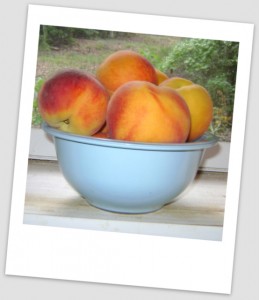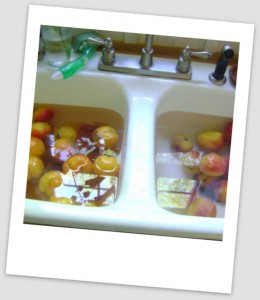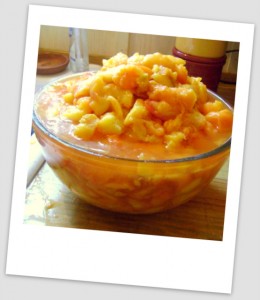 We have had the good fortune to have access to lots of peaches this summer, and I have set out to make use of every one and not let any go bad. We are also selling 1/2 bushel boxes to anyone in our vicinity that places an order each week.
We have had the good fortune to have access to lots of peaches this summer, and I have set out to make use of every one and not let any go bad. We are also selling 1/2 bushel boxes to anyone in our vicinity that places an order each week.
After quite a few women asked me how to process them for freezing, I told them that I merely blanch them, cut them from the pit in pieces, and freeze them in quart or gallon freezer bags. However, after all of them looked at me blankly when I said “blanch”, I thought maybe others would benefit from knowing how to do it. I have tried it different ways, but this is by far the best and easiest way to me.
I was in college when I accidentally learned of this method from a friend who was late to a Christmas party because of the tedious task of blanching almonds. Ever curious, I investigated this technique I had never heard of and found it to be quite quick and easy. Turns out that was a good sounding excuse as a cover up for a traffic stop! But, moving forward…
Wikipedia defines the term this way: “The meaning of blanching is “to whiten”, but this is not always the purpose of blanching in cooking. Food is blanched to soften it, or to partly or fully cook it, or to remove a strong taste (for example, bacon, cabbage, or onions).
When almonds or pistachios are blanched, the skin of the nut (botanically the seed coat surrounding the embryo) softens and can be easily removed.
The technique of blanching vegetables is best illustrated by the requirement to stop cooking asparagus, otherwise the asparagus would become soggy due to it continuing to cook after it is removed from the boiling water. To cook asparagus using the blanching method, the shoots are boiled for 30 seconds, and then to stop further cooking, are dipped in to cold or ice water. Note: The term “blanched asparagus” is also used to refer to white asparagus, which is produced by a special gardening technique.”
Blanching also works on soft skinned fruits, such as peaches and vegetables, such as tomatoes, in the same manner that it works on almonds and pistachios. This was an amazing discovery for the processing of gallons of tomatoes every summer.
Figuring peaches were of the same design, I decided to give it a go the first time I had a lot to process. Previously I had peeled peaches with a paring knife, which was not only time consuming, it also wasted a lot of the fruit.
To blanch for the purpose of skin removal on peaches, I get out a big pot, fill it with water, and heat to boiling. I fill one side of the sink with cold water and a little ice, and the other side with cold water. I set out a 2 large bowls, one to hold the pits and bruises, and another to hold the cut up peaches. My method is not the “right” way, it is just what I found works best for me.
 When the water starts boiling, I use a slotted spoon to dip each peach from the box into the water. I keep adding until the pot is full (usually one layer deep). I let it boil 30 to 60 seconds and then use the slotted spoon to dip them out of the boiling water and into a waiting receptacle (I use the lid from the pot, but if the sink were by the stove, I would dip them straight to the ice water) and then carry them over to put them into the ice water.
When the water starts boiling, I use a slotted spoon to dip each peach from the box into the water. I keep adding until the pot is full (usually one layer deep). I let it boil 30 to 60 seconds and then use the slotted spoon to dip them out of the boiling water and into a waiting receptacle (I use the lid from the pot, but if the sink were by the stove, I would dip them straight to the ice water) and then carry them over to put them into the ice water.
I repeat this until the ice water side is full and then stop to finish those. I take them one at a time and move them to the cold water side and the skin just literally slips off the peach. (If it doesn’t, increase the boiling water bath a little). I leave the removed skin and the peeled peaches floating on that side until I have emptied the ice water side. I then began the next step of cutting them up and placing the good parts in one bowl, and the pit and waste in the other. Then to the freezer bag and freezer. I repeat all the steps until I finish the box.
With a 1/2 bushel box (which is about 25 lbs), I can get 6 or so quarts of cut up peaches…ready for icecream, pie, cobbler, bread pudding, preserves, or just plain ol’ peaches and cream.
I also end up with a nice big bowl full for the compost pile or the chickens…